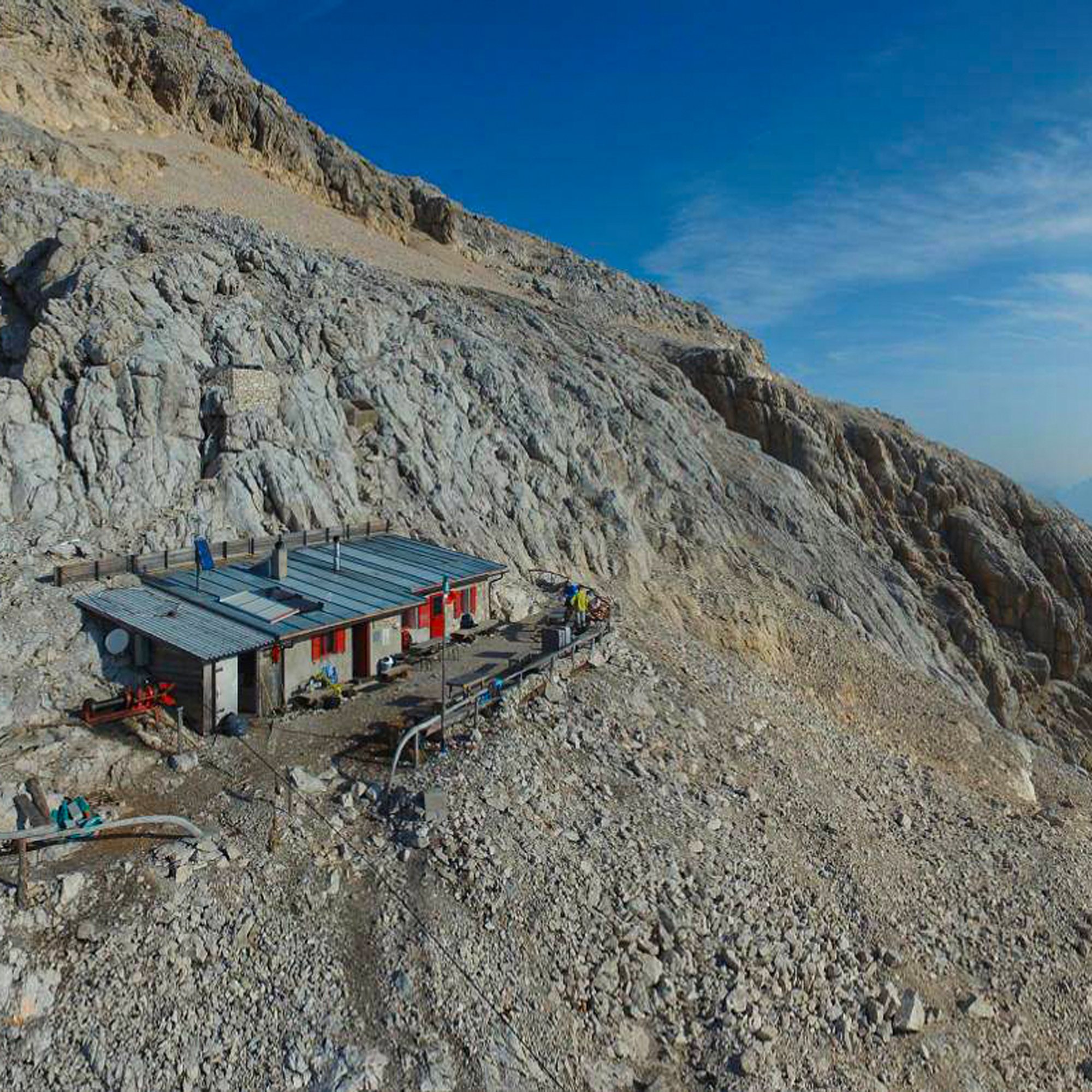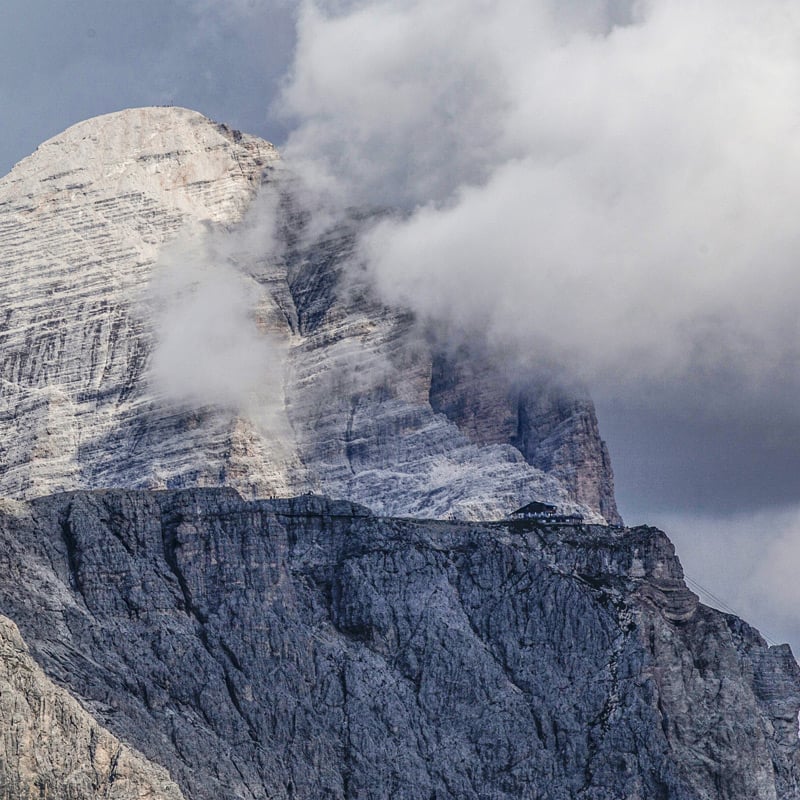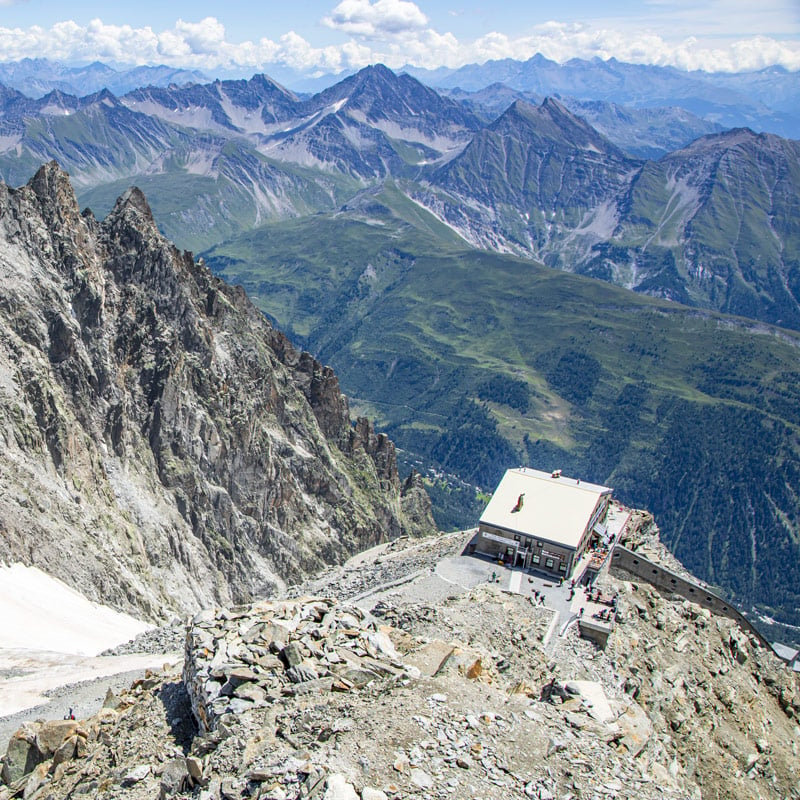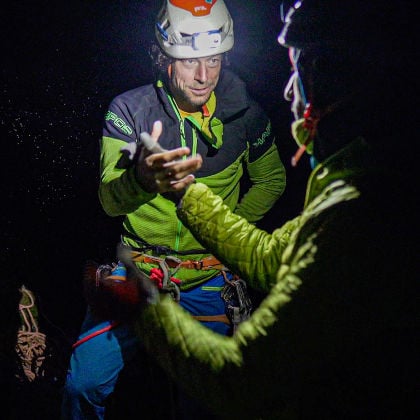
IN THE HEART OF MONTE CIVETTA, RIFUGIO TORRANI
We first heard about Venturino De Bona from Manrico Dell’Agnola. The man who did Philipp-Flamm in 2 hours and 40 minutes knows De Bona’s story well, and also the rifugio he manages at the foot of the Civetta wall. “Here, Venturino is part of history.” Little is known about his (difficult) climbs and, often, the stories heard in the evenings in the rifugio are new. It’s the fault of humbleness and, perhaps, that trace of shyness hiding behind Venturino’s words. “Fault” because it keeps us from being able to tell an exemplary story, of mountaineering practiced out of passion in nearby mountains — the mountains to which his entire life, both personal and professional, is linked.
Venturino De Bona is the cordial manager of Rifugio Maria Vittoria Torrani. A refuge in the true sense of the word, and probably the most extreme accommodation facility in the Dolomites, a UNESCO World Heritage Site. An eagle’s nest positioned in a strategic place, at the foot of Monte Civetta. A fundamental point of support for anyone intending to approach the 3,000-meter Dolomite peak, either via the normal route or one of the more difficult and iconic itineraries.
Manrico, a photographer and mountaineer, has always gone there. He knows every inch of it. He’s experienced it in all conditions. “I don’t think I’d be so attached to this rifugio if I hadn’t met Venturino,” he says. A man of matter-of-fact words and a penetrating gaze, Venturino. The welcoming manager retains a natural shyness that he sheds over time. At the beginning he’s silent and reticent to talk about his mountaineering, but as the hours pass and as we chat, he softens, revealing to us a world made of memories crystallized in his mind and within the walls of this small rifugio. In 2023, Torrani celebrated its first 85 years, while Venturino De Bona, who took over management in the summer of 2005, reached the important milestone of mature age. “Dynamic forty-year-old from Longarone, excellent mountaineer, member of Alpine Rescue, formerly belonging to the Regional Forestry Service and with experience as a staff member managing alpine rifugios,” is how a note from the CAI Conegliano announced the arrival of the new manager.




Venturino would have an important task: to offer shelter to mountaineers at the foot of one of the most iconic Dolomite peaks, in the highest rifugio in the Dolomites. Located at 2,984 meters, Torrani has no equals in that fragile world of delicate vertical limestone. The Torrani is a modest but welcoming shelter. Over the years, Venturino transformed it into a real haven for all the mountaineers heading to Monte Civetta. Twenty-two beds in a dormitory and a couple of rooms for cooking and eating. There’s always a hot meal available here.
Rifugio Torrani was conceived and designed in 1936 by the Conegliano CAI section, at the suggestion of the mountaineer Domenico Rudatis. Construction began in 1937 thanks to funds made available by the Vazzoler and Torrani families. Hence the dedication of the structure to Maria Vittoria Torrani, a great mountain lover, climber, and skier who died on January 6, 1935, in an avalanche. That day she was on a trip to Piz Corvatsch, in the Bernina Group, together with some friends from CAI Milan, Roberto Cazzaniga and the siblings Lisetta and Augusto Porro.
One year after the start of the work, the structure was finally ready to be inaugurated. The journalist Dino Buzzati, a huge lover of the Dolomites, also went up for the event. At the time, the climb was not at all easy and required decent mountaineering skills. For this reason, a fundraiser was organized among the members of the CAI section to pay for the development of the Attilio Tissi via ferrata, which still leads to the rifugio today.
It must be said, for the sake of accuracy, that there are no easy or short routes to reach the rifugio. We are still talking about a structure built for mountaineers. And, in fact, whatever route you choose, you need to count on four to six hours of hiking on technical terrain, where you need knowledge of the mountain environment and its difficulties. In short, we’re talking about a real eagle’s nest.

The rock of the Civetta is reflected in Venturino’s eyes in the evening, when he finally has time to stop and look up, to pause amid the thoughts of the day gone by. The guests have their last drinks before going to bed, and the sky begins to glow with the colors of the sunset. Another day is over and the quiet begins to blanket the old walls of the rifugio. It’s in these moments that the manager opens up more willingly, remembering his mountaineering, disclosing previously unknown images.
Like the first ascent of “Nuvole Barocche,” which he climbed together with Piero Bez in 1999. A route that rises upward, more or less straight to the center of the face, passing the northeast of the Civetta. A wall that’s not only immense; it’s also wild, to the point that it seems unattainable with its almost 1,200 meters of elevation gain. Venturino says little, but he lets us understand how connected he is to those invisible traces on the rock. His eyes capture every bend, following the sequence of moves. He remembers them all, as if it were yesterday. Yet a quarter of a century has already passed. It took him three years to set up the route. One of the hardest in the Dolomites, they say. “Started on August 17, 1996, and finished September 11–13, 1999. In total, 10 days spent on the wall with eight bivouacs, five of which were on the terrace of the Philipp dihedral, reachable with a rappel starting from the height of the ninth pitch.” This is how De Bona describes the days of the first ascent. “Two of the other bivouacs were on a hammock at the end of the 18th pitch (under the large roof), and another in the couloir at the end of the 23rd pitch. The first three pitches are shared with the Philipp dihedral, and the 26th and 27th are shared with the Comici. The last three pitches follow a 1989 variant on Philipp that was developed by Spanish mountaineers.” Anyone wishing to try to free climb it, he says, would need to spend at least three days on the wall.Venturino knows this wall like the back of his hand, and it couldn’t be any other way.
Anyone who manages a rifugio like the Torrani must do more than just offer hospitality. His tasks are much broader. His is the first aid station. Venturino is the first to act when there are problems to solve and the last to go to sleep once all his guests have returned from the climb. The Torrani is a necessary stop for anyone who wants to reach the top of Monte Civetta. The normal route passes by the rifugio, as does the via ferrata that connects Passo del Tenente with the summit. Those who follow the Tissi and Alleghesi via ferratas can choose a pleasant refreshment stop at the rifugio, as can those who tackle the difficult northwest route. Everyone is welcomed with a hot dish, a nice glass of wine, and the friendly smile of Venturino, the silent guardian of the Civetta.
THE UNEXPECTED ADVENTURE
Until a few years ago, the Philipp-Flamm dihedral was considered a difficult and serious route. With regard to the seriousness, there’s not much to say, as it’s a characteristic shared by all large walls; in terms of the technical difficulties, though, it’s clearly been surpassed by other climbs on that same side of the Civetta. In my opinion, the real advance was made in 1991 with “Kein Rest von Sehnsucht,” opened in the style of “artists working without a net” by Christoph Hainz and Valentin Pardeller, the same style used by Walter Philipp in that distant 1957, with only normal bolts ... and few of them. (That time, Christoph found some bolts in the initial part, placed by others in other attempts, and a fierce controversy arose over the use of those bolts in the mountains ... how things change.) Now on the great northwest face of the Civetta, various truly difficult routes, more or less modern, have been developed and repeated in summer and winter by today’s strongest climbing teams.
But let’s get back to us. It was the summer of 2006, and the following year would have been the 50th anniversary of the first ascent of the legendary Philipp route, and at that time the prestigious Alp magazine still existed, edited then by Linda Cottino, who contacted me to create a piece commemorating this great climb. The request was for an interview accompanied by images of that climb, featuring myself as the author of the last exploit on that route: in 1990 I climbed it unroped in a short time, 2 hours and 40 minutes, according to the watch of the attentive Nani Da Canal, then manager of Rifugio Tissi, who that day didn’t let me out of sight for a moment with his telescope.
It wasn’t easy to pull it together, between misunderstandings and dirty tricks, but finally the moment for action had come. We met one evening, all at Rifugio Tissi. The “gang” was made up of me and five mountain guides: one team in front, with their second serving as photographer; me and my partner; and the third group who followed us out of congeniality ... better to put it that way.
To tell the truth, I was the first to pull back, in the sense that I didn’t want to start too soon — a matter of the light, I said, still unaware of the epilogue, which in any case was more comical than tragic. It wasn’t very early, but we all figured we knew what we were doing. The first pitches were uninteresting, so no spotlights up to the dihedral, but a problem was already emerging: due to the movement on the wall by the first two teams, the third team had to dodge some small stones. It’s impossible to climb without slightly moving the surface, even if you pay as much attention as possible. We solved it by roping them up with our team, but this started to waste precious time. I also realized that all in all, it wasn’t really a trail. We began to get nervous. On the dihedral the photographer did his job, and I did mine, but without the possibility of a reshoot; the first one was good anyway, so we went on up.

Finally, we arrived at the large “miracle” ledge; now the route went straight up toward a series of gloomy black and wet chimneys, not very inviting at all, but the route passed right through there, despite instinct leading elsewhere. There was a beautiful stop on a small terrace with three nice bolts and ropes; I still have it imprinted in my brain. I’d climbed the route four times, and one of the others had brought a client there a short time before, but nevertheless we somehow veered to the right and made a huge mistake. These things happen, but the problem was the time; it was already quite late.
I called my wife, who laughed. She told me that she’d already heard from Walter and that for some time down in the valley they’d been imagining what we we’d gotten up to. After two or three pitches we found ourselves inside a large niche, absolutely off the route. One of our group tried to climb a little farther up a beautiful gray slab, which was anything but easy, but farther up he couldn’t find a solution, also because it was getting dark, so he came back down to where we were. From above, some worn ropes hung straight down the face; with the last light and agitated by a cold breeze, they truly gave us the shivers. We were in a mess and it was now dark. Even though it was the height of summer, it wasn’t warm up there at all. It’s never warm up there. It wasn’t what any of us preferred, but all things considered we were taking it well. Someone had a heavier jacket, others only a fleece, one pulled out a space blanket, which we divided into many small pieces. Between some candy and an energy bar, a lot of bullshit and little to drink, the short but freezing summer night passed without any particular problems. In the end, we were five professionals (and myself), and we were not the least bit intimidated by the situation.
Now all we had to do was get out of there. There was no question of going back down to go up the “correct route”; the only solution was to cross to the right toward Comici and, via the Cassin variant, exit onto the ridge. I knew the face well, but to tell the truth I didn’t know where I was climbing that day. The fact remained that with rotten traverses and wet gullies, at 11 we were all safe and sound on the ridge, not too far from the summit. I remember the pleasure of the sun that we’d wished for all night long. Coming out of a north face after a bivouac is always a beautiful experience. With the warmth of the August sun, we went from hell to heaven in a second — the exit from the abyss. We collected the ropes and reorganized the gear as best we could, and a short time later, at Rifugio Torrani, the friendly welcome from Venturino De Bona made us feel at home and the small rifugio seem like a palace. Enjoying a little food but especially beer, I remember the happy group around the table and a bit of that survivor feeling, that cold you feel in your bones after every bivouac that makes you want to absorb every little pleasure, and a sense of peace. An unquenchable thirst that makes beer even more satisfying. Priceless and rare moments made possible only by that mistake, a straightforward day transformed into a minor adventure. Time passed quickly. Up there the view was amazing, the sun was warm despite the almost 3,000-meter elevation, and we felt not even the slightest desire to go down.


